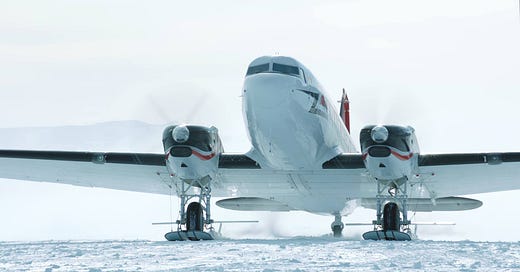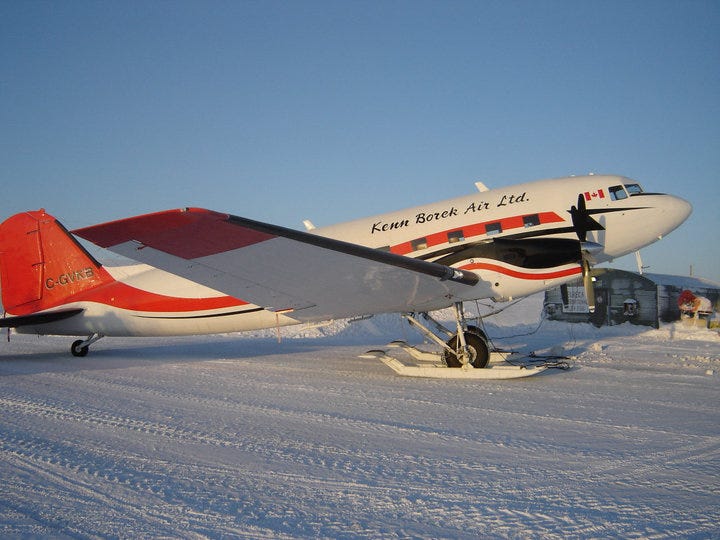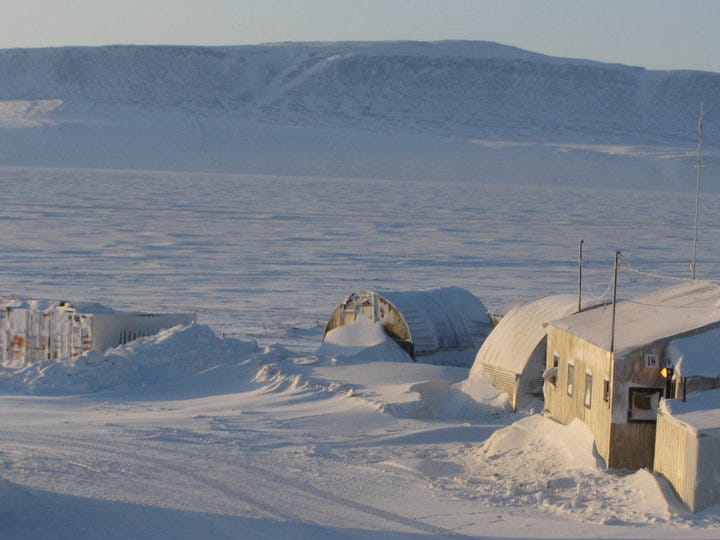As some of you know, I spent the greater part of a decade working in the high arctic and Antarctic. I had many wonderful experiences throughout that time. After some friendly encouragement, I decided to share some of these experiences with you, and this is the first one.
Years ago, I was working as an Aircraft Maintenance Engineer (AME) out of Resolute, Nunavut on a Basler BT-67 (turbine DC-3). On this particular trip we were hauling a group of skiers up north as they were to depart on a ski trip to the North Pole.
We were landing at a place called Camp 82, which was just a snow-filled gap between two peaks of the Challenger Mountains with a fuel cache marked by a flag. Camp 82 got its name from the fact that it was situated on the 82nd parallel at the northern end of Ellesmere Island.
On our way there, we received word that some weather was moving into Resolute which was going to sock in the airport for “a while” and we should get back as soon as we could. Once our passengers were on their way, we needed to refuel from the fuel cache. This became an adventure of its own which ended up having a career-changing impression on me, but that’s a story for another day.
Once refueled we headed home. Not long into our flight dispatch told us that the weather had moved into Res sooner than forecast and the airport was closed. This left us with two options. Head north to Canadian Forces Station (CFS) Alert, which is the most northern, permanently inhabited place on earth, located at the tip of Ellesmere Island, or Eureka, the Environment Canada station in the middle of the same island. Since we were already heading south and Eureka is closer to Resolute, we chose Eureka.
Upon landing we quickly put our Basler to bed, wrapping the insulated, fitted engine covers, known as engine tents, around the engines and plugging in the electric engine heaters. Grabbing our gear, we headed off to the main part of the station to find a warm place to rest and wait out the storm.
Once there, we came across another hiccup. The base was full, with no spare beds. Two crews were scheduled to transfer out that day, but, due to the same weather that took out Res, their flight out of Iqaluit was cancelled. After some brainstorming a station employee mentioned that one of the old buildings from the original base, build in the 1950s, still had some prepared bunks, they just needed to turn on the heat. This was a huge relief.
As we walked the few hundred feet that separated the old and new base, we passed some of the remaining buildings from the old base, located on the shore of Slidre Fjord. Our destination was an old metal building. At first glance it looked to be several shipping contained stuck together rather than a building. I was expecting to see a row of bunks and a heat stove, basic military style accommodations, but upon opening the door I was transported back to the 1970s. The walls were covered in wood paneling, four single beds with wood frames on the left side, and a table and couch on the right. The bedding and furniture employed era-appropriate floral patterns. A single electric heater located next to the main door provided our only source of heat. It wasn’t pretty, but it was a bed, and we eagerly dove in after a long day in the cold.
The next morning began right where the previous day left off, with more troubles. I awoke around 6 am and I instantly felt those unwelcome sensations that anyone who has slept in the deep cold will remember. The tip of my nose was near frozen, the air nipped at my throat as I inhaled. While my body was still warm in my cocoon of blankets, I knew that the slightest crack would allow a rush of cold air to penetrate my fabric shield, shrinking all the vital bits, and leave me shivering. The lone electric heater had quit in the night and the frigid outside air was filling the shack.
It was right about this time that the pilots started to wake up. I knew this because, out of the silence, the captain, a kind but cantankerous old chap, firmly stated. “Holy crap it’s cold in here!” The co-pilot, like all good co-pilots following their checklist, repeated the captain’s statement “It is cold in here”. This was quickly followed with “the heater must have quit”, clearly exhibiting the co-pilot’s keen situational awareness and troubleshooting skills.
What followed was a cordial conversation among a solid crew. “Hey, engineer, go fix that damn heater, I’m freezing” barked the captain. “Ya, you are the one who fixes things” followed the co-pilot. In my head, I like to think my reply was along the lines of “I am not qualified to fix infrastructure owned by the government of Canada”, but I think what I said was “I ain’t fixing that damn thing”. The captain came back with “I’m not getting out of bed; I’ll freeze my ass off”. The co-pilot chirped in, whimpering a deeply intellectual “ya!”.
It was at this point I knew this circular conversation was not going to end. So, as all good AME’s do, I decided to be the bigger person, and fix this situation. (Dear fellow pilots, sorry…not sorry)
I took a moment to mentally prepare myself for the blast of cold air. Then, in one move, I threw off the sheets and jumped into my boots. I heard “good” and “that’s right” from the pilots. I knew what had to be done. I grabbed my gear and made my way to the front of the hut.
Then, in a flash, I bolted for the front door. I launched out of the hut, leaving the pilots shivering in their sheets. Running as best I could in heavy boots and wearing only pajamas, I B-lined for the main building. Throwing open the large freezer door that is the main entrance, I dove in and bathed in the warm air of the base.
Just inside the main entrance, is the cafeteria. I walked in to find it empty. I sat down to start thawing out when I heard a voice, “Can I make you anything?”. Behind the counter was a friendly gentleman, named Bill. He was a member of the Canadian Armed Forces and the station cook. Seeing some bacon and eggs on the grill I said whatever he had cooking would do nicely. Being so cold, and not expecting any food, I think I thanked him at least half a dozen times.
About half an hour after I made it to the safety of the main building, the pilots walked in. Finding me not only thawed out and comfortable, but enjoying a steaming plate of delicious food, only added to their discontent. The captain started with various four-letter words and mentioned the terms frozen, nuts, and cold, several times. The co-pilot echoed the sentiments. After warming up and getting some breakfast themselves, the captain leaned over and said the sight of me leaping through that door did make him laugh, but that I was still a prick for doing it.
After breakfast, we made our way to the operations office to check on the weather. The system had moved, which allowed the crew transfer flight to depart Iqaluit. This meant we would have beds in the main station building if we needed them. As it turns out, we would. While the weather had opened in the east, it stalled over Resolute and wasn’t going anywhere. Seeing we would be here for a while we settled into our new, warm, accommodations and decided to go check on the plane. This is when we met the station custodian, Jack. When we explained the heater malfunction from the previous night, he said “oh ya, when that thing hasn’t run in a while it always kicks out when it gets this cold”.
The next day or so was pretty quiet. Regular weather checks confirmed the system was still stalled. A couple times each day we would drive a couple miles up the hill to the airport to check on the plane. The rest of the time we spent in the station lounge. There was a small bar (that came in handy) as well as a pool table, a movie room, and a library. More than enough stuff to keep you busy.
On roughly day three of our extended stay, Jack stopped me, he said, “Hey, I need you to come with me up to your aircraft. There are some animals around it and I think it might be damaged”. So, we headed out to the plane. Once there we didn’t find any damage on the aircraft, but we did find that the electrical cords for the engine heaters had been chewed. I’m sure some creature got a rude awakening from that one. Jack informed me that the base had been having a lot of trouble with Artic Wolves chewing power chords. He didn’t know why, but they obviously found ours to be tasty as well. We brought the chords back to his shop and fixed them up, good as new.
By this time, around 10-11pm, it was well past dark for the north and we headed back to reinstall the chords so the engines would stay warm. Using the headlights of Jacks truck to see, I plugged in the chords and then jumped onto the wing to install them on the engines. Jack sat back in the truck to warm up while I did my final checks and confirmed the engines were warming again.
It was at that point that I had a weird feeling, the one you get when someone is watching you. I looked around and at first, I didn’t notice anything, but then, out of the corner of my eye, a pair of yellow eyes appeared in the darkness a few feet away from the wing tip, staring at me. I stood up on the leading edge of the wing to get a better look, as I did, a lone wolf strolled into the light. Not the biggest wolf I had ever seen, but big enough to make me unsettled. He calmly paced back and forth around the wing tip.
I knew I couldn’t hop down off the wing as he was waiting for me. I was safe on the wing but also freezing. It was at that point the real danger came to mind. Wolves don’t hunt on their own. This little fella was a decoy. Strolling in front of the wing, if I were to simply react and jump off the back, there, waiting for me, would be the rest of his pack. Taking a look off the back of the wing confirmed my suspicions.
There, I could faintly see multiple sets of eyes just barely visible in the light. I didn’t have to think long on how to get out of this. Jack noticed the first wolf. He saw me look toward the back of the plane and knew exactly what was happening. Honking his horn, he pulled up to the front of the wing. He rolled down the window, yelled, and motioned for me to jump into the box of the truck. I didn’t hesitate. As soon as I was firmly in the back, Jack floored it, fearing a wolf may try to jump in the back with me. We sped off heading straight for the station.
Back at the station Jack and I settled in to relax and absorb what happened. This we found was best accomplished at the station bar. We met up with the pilots to give them a rundown of what had happened and decided to get a better, and safer, look, in the daylight.
The next morning, we headed out to the plane and found no additional damage to the aircraft or cords. All was good. We decided to check the weather one more time. Once again, the system was still firmly parked over Resolute. For several more days we followed the same routine, wake up, check the weather, check the plane, eat, and repeat, waiting for that system to finally lift.
Luckily the wolves had lost interest in our plane. They had moved on to to some scientific equipment at the far end of the runway. This move was aided by the misguided habit of a few of the new junior scientists, who thought it was ok to leave food for them.
After almost an entire week the weather system finally moved on. After packing our belongings and bidding Eureka farewell, we made our way back to Resolute. Thus ended one of the most memorable, unplanned, trips of my career. It was experiences like this that make working up north so unforgettable…who says being an AME is boring?










